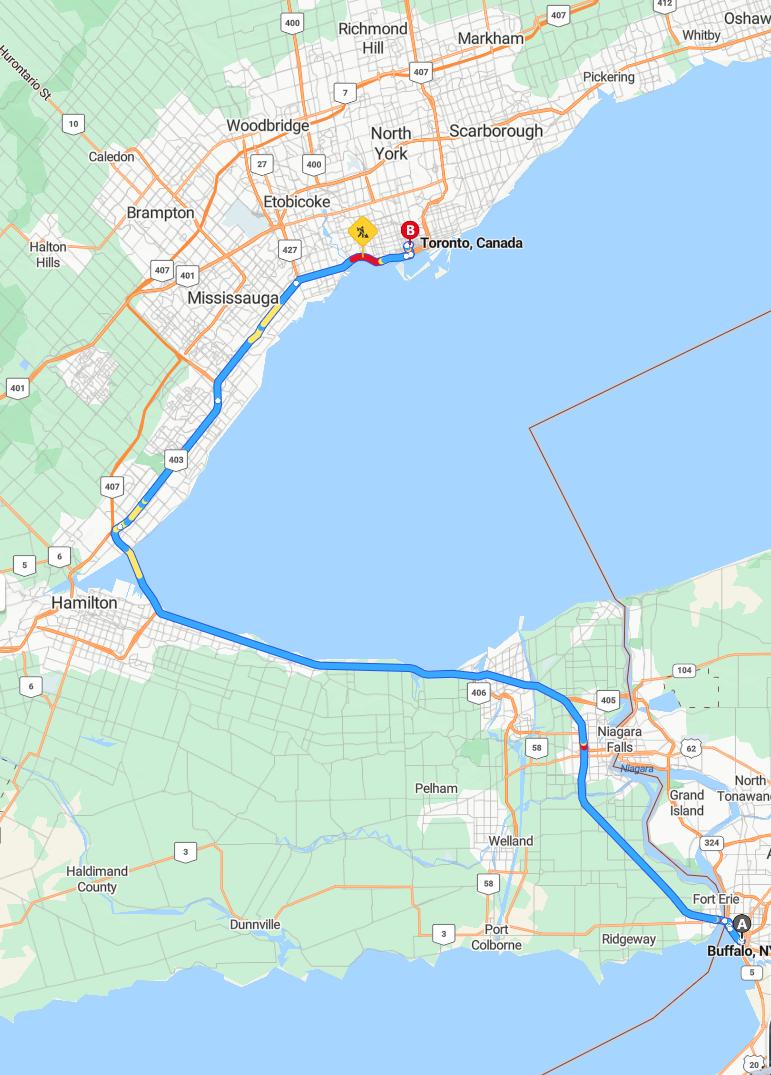Distance and estimated driving time
The drive from Buffalo to Toronto covers approximately 99 miles and takes an estimated 1 hour and 42 minutes. Travelers typically follow the Queen Elizabeth Way (QEW) and ON-403 highways for this route, ensuring a scenic and efficient journey. Traffic conditions and border crossing times may influence the total travel duration. Planning ahead can help optimize your trip and minimize delays.
Driving route
Traveling from Buffalo to Toronto offers a scenic and diverse route through the Great Lakes region. Starting in Buffalo and passing through Cheektowaga and North Tonawanda, travelers can experience suburban charm before reaching Grand Island, known for its parks and natural beauty. Continuing toward Niagara Falls, visitors can enjoy the iconic waterfalls and related attractions. The route then crosses into Canada through Welland, Port Colborne, and Ridgeway, highlighting historic port cities along Lake Ontario. Finally, the journey concludes in Toronto, a vibrant metropolis renowned for its diverse culture, skyline, and entertainment options.

Best departure times for avoiding traffic
To avoid heavy traffic when driving from Buffalo to Toronto, it is best to depart early in the morning, ideally before 7:00 AM, as this timing typically ensures a smoother drive through Buffalo, Cheektowaga, and North Tonawanda. Late mornings and early afternoons can be busier due to local commuter traffic and any ongoing activities near Niagara Falls and Welland. Traveling during late evenings after 7:00 PM may help you avoid peak times, especially around Fort Erie and the border crossing into Toronto. Planning your departure during off-peak hours ensures a faster, less stressful journey along the route through Grand Island, Niagara Falls, and into Toronto.
Important border crossing tips and documentation
When driving from Buffalo to Toronto, it's essential to be prepared for the border crossing between the United States and Canada. Ensure you have valid travel documentation, such as a passport or enhanced driver's license, to facilitate a smooth entry into Canada. Be ready to answer questions about your trip and declare any goods or items you're bringing across the border. Additionally, familiarize yourself with customs regulations to avoid delays or issues during the process.
Scenic spots along the route
Along the drive from Buffalo to Toronto, travelers can enjoy a variety of scenic attractions. Starting in Buffalo, the views of Lake Erie set a beautiful tone for the journey, and nearby Grand Island offers picturesque waterfront scenery. As you approach Niagara Falls, the iconic waterfalls provide breathtaking natural beauty, while Welland's historic canal and locks showcase impressive engineering. Continuing toward Toronto, the route features lush countryside and charming towns like Port Colborne and Ridgeway, offering a scenic glimpse of the region's diverse landscapes.
Local traffic laws and driving regulations
When driving from Buffalo to Toronto, travelers should be aware of varying traffic laws and regulations across jurisdictions. In the United States, including Buffalo and its suburbs like Cheektowaga, drivers must adhere to local speed limits, enforced by radar and laser technologies, and observe regulations such as seat belt use and prohibited cell phone use while driving. Upon crossing into Canada, particularly in Ontario, drivers are required to carry valid insurance, obey specific rules like moving over for emergency vehicles, and adhere to different speed limits, which are strictly enforced. It is essential for drivers to familiarize themselves with regional traffic signs and legal requirements to ensure safe and compliant travel throughout the route.
Recommended rest stops and fueling stations
When traveling from Buffalo to Toronto, it's advisable to plan your rest stops at key locations such as Niagara Falls and Welland, where there are numerous rest areas and cafes to refresh and stretch. Fueling stations are conveniently available along the route in Cheektowaga, North Tonawanda, and Fort Erie, ensuring your vehicle remains well-fueled before entering the busy Toronto area. For a longer pause, consider stopping in Grand Island or Port Colborne, which offer additional amenities and scenic spots for a quick break. Proper planning of rest and fueling stops will make your journey smoother, more comfortable, and safer.
Currency exchange and payment options
When traveling from Buffalo to Toronto, it's essential to consider currency exchange options and payment methods. In Toronto, the primary currency is the Canadian dollar (CAD), so travelers should plan to exchange some US dollars (USD) beforehand or upon arrival. Many banks, currency exchange offices, and even some hotels offer currency conversion services, often with varying rates and fees. Additionally, credit and debit cards are widely accepted throughout Toronto, providing a convenient and secure payment option, though travelers should be aware of potential foreign transaction fees from their banks.
Weather conditions and seasonal considerations
Traveling from Buffalo to Toronto, travelers should be mindful of seasonal weather conditions that can significantly impact the journey. During the winter months, heavy snowfall and icy roads are common, especially around Niagara Falls and Fort Erie, requiring cautious driving and potential delays. Summer travel typically features milder weather, but occasional thunderstorms can occur, especially in the Welland and Niagara region, so staying alert is advisable. It's essential to check local weather forecasts before departure to ensure a safe and enjoyable trip through the diverse seasonal conditions along the route.
Safety tips for cross-border travel
When traveling across the border from Buffalo to Toronto, it is essential to prioritize safety to ensure a smooth journey. Make sure to carry all necessary travel documents, such as passports and any required visas, and keep them easily accessible. Stay vigilant while driving, obeying speed limits and traffic laws in each location, including Niagara Falls and Fort Erie, where conditions can vary. Additionally, stay updated on border crossing requirements and potential delays, and maintain awareness of local health guidelines to ensure a safe and hassle-free cross-border experience.
